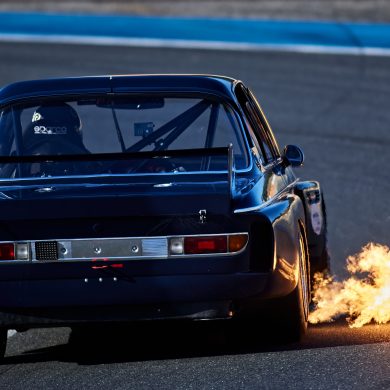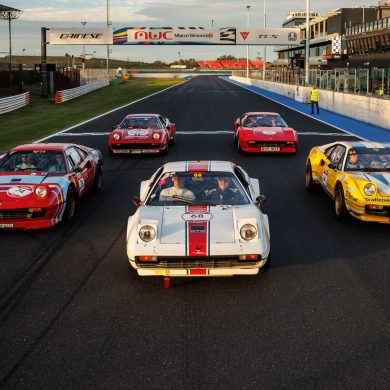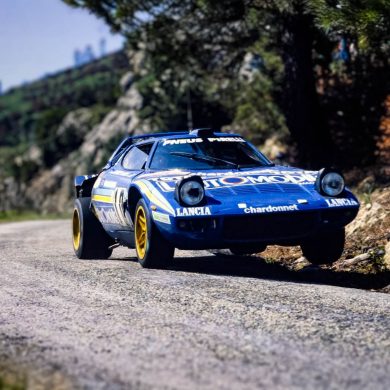Phillip Island Classic, March 19-21, 2010 Australia
Report and photos by Vince Johnson

Irreplaceable cars regularly arrive from the UK Europe and USA to spend time doing what they were built for. The Porsche Museum sends treasures of the calibre of Mark Donohue’s 917/30 Can-Am spyder. This year, from south of the Alps, Alfa Romeo sent an Alfetta 159 to help commemorate their centenary in the car business.
50 years ago Sir Jack Brabham won his second world driver’s title. The organiser of the Classic, the Victorian Historic Racing Register, is fortunate to have Sir Jack as its Club Patron and the 83 year old’s wrist was kept busy in the paddock over the weekend. It was also half a century since the first 500 mile race for touring cars, known these days every October as the Bathurst 1000, was held at Mount Panorama in New South Wales. The pits and paddock were filled with 60’s and 70’s Mustangs, Falcons, Toranas, Cortinas and Minis waiting for the hotly contested Group N races. The Toranas were celebrating their 40th birthday. Holden’s mid-sized giant killer on the tracks of the early seventies was a popular display behind the pits.
The Formula 5000s were back. It seemed there were more cars on the grid for the three races than lined up four decades ago at tracks across Australia and New Zealand. It certainly sounded like it. Chris Hyde in the 1972 McRae GM1 and Ken Smith (1976 Lola 430) shared fastest lap and top step of the podium in their three races. In Groups Q & R, Andy Newall had his work cut out in the Brabham BT26, running second to Guido Belgiorno-Nettis’ Ferrari 156/85 each time. There were record entries in Group S. Jason Lea was uncatchable in his 1968 Group T Datsun 2000 in Sa & Sb, while in the Sc races the Porsche 911s of Geoffrey Morgan, Terry Lawlor and Stan Adler swapped top three places all weekend. Paul Blackie’s lone Corvette Stingray upheld the General’s honour in the over 5 litre class among the three Panteras.
Two overseas cars raised the beauty stakes in Groups J, K & L. Andrew Cannon’s 1956 Maserati 150S, one of 26 built, was sold new by the factory racing section to San Franciscan Chick Leson and later fitted with a 2.5 litre engine. Aston Martin DB3/S chassis #11 was the third of four works-spec cars built by the factory prior to their 1959 DBR1 Le Mans winner. Tony Brooks used it as a mule for the 1957 Nurburgring 1000km. Sold by John Wyer to Californian Rod Carvath, who ran it in the US, at Nassau and also in Australia, it has had success at Pebble Beach and is a regular competitor at historic events in Europe and the UK.
Andy Newall also spent track time in the ex-Autodelta Alfa Romeo T33/3 that came second in the 1971 Targa Florio. With meeting patron Kevin Bartlett he shared a European-based 1964 Alfa TZ1, also driven by Gordon McCulloch and Chris Clegg. As an invited entry into the Formula Ford and Groups M & O races, they mixed it with open wheeler Brabhams, Elfins and Lolas. The Regularity events, where drivers attempt to consistently lap at an estimated time, were well supported. This year there was an Alfa-only category as well as the usual Divisions 1 and 2 and many of the race entries came out for extra track time. Annual competitor Peter Giddings shared his 1931 P3 with Jack Quinn.
Demonstration laps between these events gave spectators the opportunity to hear and smell some of the display vehicles. The Alfetta blew some cobwebs away but only gently, later heading to Melbourne and the Formula 1 Grand Prix. Rod Hadfield’s Warman Special isn’t a classic yet but one day it may well be. With a lengthened chassis, front end, wheels, suspension and brakes from a 1932 Packard Limousine, it’s 1650 cubic inch Rolls Royce Meteor V12 puts out 1550 ft lbs of torque at 1600rpm.
Each year the cars get older, some of them get faster and the anniversaries keep coming. Drivers age but their enthusiasm doesn’t. Trophies are awarded and race records are kept. And the planning begins for next year’s festivities.

























[Source: Vince Johnson]









